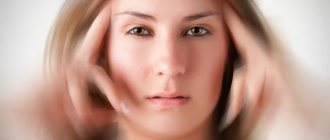The most common diagnosis nowadays is vegetative vascular dystonia. The disease is a range of symptoms that occur when there are disturbances associated with the normal functioning of the cardiovascular system. At the same time, a serious disturbance occurs in the autonomic nervous system, which serves in the body to regulate vascular tone and heart rate, and it cannot normally cope with the changes that have occurred. Frequent dizziness and fainting with vegetative-vascular dystonia frighten a person and cause nervousness, preventing them from living a normal, fulfilling life.
Why do fainting occur?
As a result of vegetative vascular dystonia, sharp changes in blood pressure begin. Due to poor circulation, the brain receives an insufficient supply of blood and oxygen and vegetative vascular paroxysm (loss of consciousness, fainting) occurs, which serves as a protective reaction of the body. Mostly, fainting occurs in younger women, during periods of emotional upsurge.
The brain functions continuously around the clock. It regulates the activities of all organs in the body. In order for it to function effectively, it needs an uninterrupted, constant supply of blood, oxygen, and nutrients. In a patient with vegetative vascular dystonia, a sharp disturbance of vascular tone often occurs, blood suddenly drains from the brain. There is little oxygen and fainting occurs.
Vegetative vascular dystonia entails a sharp decrease in blood pressure, darkening of the eyes, the patient turns pale, excessive sweat production occurs, the heart rhythm is disturbed, and the legs become weak. This condition ends with fainting due to vegetative vascular dystonia.
Most often, fainting occurs:
- Due to emotional or physical stress, overwork, overstrain;
- With severe stress or sudden fear, fainting occurs;
- During sudden changes in weather and climate;
- If a person spends a long time in a room where there is stuffy, stale air, fainting may occur due to vegetative vascular dystonia;
- With a rapid change in posture, mainly with a sharp transition of the body from a lying position to a sitting position;
- If a person drinks alcohol, fainting may occur due to vegetative vascular dystonia;
- During heavy physical activity;
- At the sight of blood, feeling fear.
In most patients with vegetative vascular dystonia, fainting is preceded by a prefainting state, he feels:
- Feeling sick;
- Dizziness with vegetative vascular dystonia is a precursor to fainting;
- The patient’s vision begins to darken and spots appear – the main symptom of fainting due to vegetative vascular dystonia;
- Anxiety, panic, fright due to vegetative vascular dystonia;
- Nausea;
- Ringing in the ears as a precursor to fainting due to vegetative vascular dystonia;
- Severe weakness;
- Increased sweating;
- Lack of air;
- Coldness of the upper and lower extremities, numbness, trembling, also with vegetative-vascular dystonia, is a precursor to fainting.
Within a couple of seconds to two minutes, after the onset of such symptoms, fainting is possible due to vegetative vascular dystonia. Syncope is not life-threatening, but the risk of losing consciousness is that the patient may be seriously injured if they fall.
The state of fainting with vegetative vascular dystonia does not last long. Within 1-3 minutes the patient regains consciousness on his own, without any assistance. If fainting occurs over a longer period of time, then the cause of its occurrence may no longer be vegetative vascular dystonia, but a completely different disease.
Diagnostics
Diagnosis begins with interviewing the patient. Therefore, before going to the doctor, it is important to prepare and remember all the complaints that arise before and after the attack. The variety of symptoms in different systems and organs often immediately tells the doctor about a possible diagnosis of “vegetative-vascular dystonia”. During an objective examination, specialists may not find any deviations from the norm.
Basic instrumental studies:
- clinoorthostatic test – assesses the function of the autonomic nervous system; allows you to evaluate the speed of change in heart rate and blood pressure when moving from a horizontal to a vertical position;
- ECG – tests cardiac function;
- Ultrasound Dopplerography of the vessels of the head and neck - allows you to assess the speed of blood flow through the main vessels;
- electroencephalography – determines the functional activity of the brain.
Fainting with vegetative vascular dystonia
There are four types of vegetative vascular dystonia: mixed vegetative vascular dystonia, hypotonic, cardinal, hypertonic. With neurosis (a frequent companion to vegetative-vascular dystonia), the functioning of two sections of the autonomic system, namely the sympathetic and parasympathetic sections, malfunctions. The most frequent dizziness and fainting with vegetative-vascular dystonia occur in patients who have this disease of the hypotonic type, less often - of the mixed type.
At this time, the following processes occur in the body:
- Failure in the parasympathetic system leads to weakening of the walls of blood vessels, which lead to fainting;
- Blood pressure suddenly drops;
- The blood does not function sufficiently, and therefore fainting occurs;
- The brain does not receive enough blood and oxygen;
- Hypoxia, which leads to fainting.
Fainting with vegetative vascular dystonia occurs in the body as a protective reaction. The brain constantly requires a fresh supply of oxygen. If its supply is insufficient, oxygen starvation occurs, and brain functions are temporarily switched off, causing fainting.
Can you feel sick with vegetative vascular dystonia? Yes, nausea and vomiting often occur with VSD. Since the digestive system closely interacts with the nervous system, when stressful situations or overexcitation occur, as well as a decrease in pressure, the frequency of myocardial contractions decreases. Blood does not flow to the esophagus, and this leads to a feeling of nausea. Vomiting most often occurs in people who have an unstable psycho-emotional background. When a person is very nervous, this can trigger a gag reflex.
First aid
When a person has a pre-fainting state, this can be noticed by a sharp pallor of the face and skin. To help him and prevent fainting, he should be taken out into the fresh air, sat down with his back against the wall, and the top buttons of his clothes unbuttoned, thus improving the flow of air.
If this does not help and a person faints due to vegetative vascular dystonia, the following may help:
- The patient should be laid on a flat surface, his legs should be raised up so that they are slightly higher than the level of his head;
- It's easy to pat him on the cheeks;
- Spray your face with cold water;
- Let him smell the cotton wool, previously soaked in ammonia.
If you don’t have ammonia on hand, you can moisten a cotton swab with vinegar or any liquid that has a pungent odor when you faint. When a person comes to his senses after fainting, he feels severe weakness and weakness throughout his body. It is not recommended for him to get up immediately; let him lie down for a few minutes. After fainting, he can sit down, leaning his back against a support. Let him stay in this position for some time to stabilize blood pressure and vascular tone. It would be nice for him to have a cup of sweet and hot tea.
How can you avoid fainting?
If a person feels faint, dizzy and weak, this condition can be prevented.
There are several ways to do this:
- Let the person try to sit down, this will reduce the possibility that he will lose consciousness, since in a sitting position fainting occurs less often with vegetative-vascular dystonia.
- Lean your back against the wall and tilt your head slightly down to increase blood flow and oxygen supply.
- Try to open a window in the room so that the room is filled with fresh air or go outside to prevent fainting due to vegetative vascular dystonia.
- Sniff a cotton swab soaked in ammonia or any other substance with a pungent odor.
- Inhale and exhale deeply a couple of times, it is advisable to use a paper bag, this especially helps with the nausea that accompanies pre-fainting.
- Distract your thoughts, for example, start counting in your head or reciting a poem to prevent fainting during vegetative-vascular dystonia.
While driving the car, you should immediately pull off the road and turn on the emergency lights. You need to drink clean water and wash your face. If possible, inform someone by phone or call an ambulance.
Is it possible to prevent an attack?
Because fainting does not develop suddenly, a person may feel an attack coming on. In this way, further development of presyncope can be prevented. To do this, a person needs to take measures to dilate blood vessels. To prevent the development of exacerbation of VSD with syncope, it is necessary:
- lower your head as low as possible - in this case blood will begin to flow to it,
- take a sitting position,
- sniff any substance with a strong odor (ammonia is ideal),
- normalize rapid breathing,
- try to do simple intellectual work - perform arithmetic operations in your head, count objects, etc.
An attack can be controlled with medication. The following medications will help stop it:
- Validol: taken sublingually, that is, the tablet must be placed under the tongue,
- Anaprilin: you need to take it if your heart rate increases,
- Relanium: taken for severe nervous excitement.
What therapy is needed for syncope?
First of all, you should contact a specialist - a therapist, a neurologist, a psychotherapist. When a diagnosis of vegetative vascular dystonia and a tendency to faint is established, sedatives and medications that improve blood circulation in the brain are prescribed as treatment: adaptogens, dietary supplements, physical procedures, exercise therapy, aromatherapy, diet, massage.
If there is fainting due to vegetative vascular dystonia, the doctor decides which drugs to prescribe - strong or weak - taking into account the degree and severity of the disease. In some cases, plant-based drops are sufficient. For vegetative vascular dystonia of the hypotonic type, tincture of Eleutherococcus and Ginseng will be useful, as they give the necessary tone to the vessels, stimulate blood flow, which to some extent increases blood pressure, strengthen the body, and prevent fainting.
Treatment
Since VSD is a disease with many symptoms, treatment is individual in each case.
Therapy begins with a non-drug direction:
- normalization of the daily routine - sufficient sleep;
- balanced diet;
- dosed physical activity - walking for half an hour a day, swimming lessons;
- therapeutic massage, acupuncture (acupuncture);
- electrophoresis with stimulants (caffeine to increase vascular tone and blood pressure).
If such methods do not improve the condition, the doctor prescribes medication: sedatives (valerian extract, motherwort); plant psychostimulants (eleutherococcus, lemongrass); agents that improve cerebral circulation (cinnarizine, trental).
A positive result also comes from personality changes - stress management, getting rid of anxiety using special techniques, meditations that you can master on your own.
Source: ogolove.ru
Tips for preventive measures
Fainting with vegetative-vascular dystonia indicates that the disease is in a more complicated form. However, if you follow all the necessary instructions, prescriptions and preventive measures, fainting with vegetative vascular dystonia can be avoided.
What does that require:
- Prohibition of smoking and drinking alcohol;
- Patients are advised to walk daily, in any weather, to avoid fainting;
- Active sports, the most preferred are yoga, swimming, race walking, cycling, aerobics, short jogging, rowing;
- Moderate physical activity;
- Regular mental stress, completing tasks, it’s a good idea to learn some language to avoid fainting;
- Healthy sleep, which should be at least 8 hours a day.












